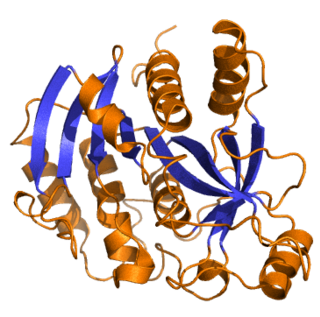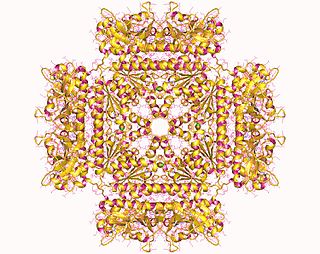| purine nucleosidase | |||||||||
|---|---|---|---|---|---|---|---|---|---|
 Purine nucleosidase tetramer, Saccharolobus solfataricus | |||||||||
| Identifiers | |||||||||
| EC no. | 3.2.2.1 | ||||||||
| CAS no. | 9025-44-9 | ||||||||
| Databases | |||||||||
| IntEnz | IntEnz view | ||||||||
| BRENDA | BRENDA entry | ||||||||
| ExPASy | NiceZyme view | ||||||||
| KEGG | KEGG entry | ||||||||
| MetaCyc | metabolic pathway | ||||||||
| PRIAM | profile | ||||||||
| PDB structures | RCSB PDB PDBe PDBsum | ||||||||
| Gene Ontology | AmiGO / QuickGO | ||||||||
| |||||||||
In enzymology, a purine nucleosidase (EC 3.2.2.1) is an enzyme that catalyzes the chemical reaction
- a purine nucleoside + H2O D-ribose + a purine base
Thus, the two substrates of this enzyme are purine nucleoside and H2O, whereas its two products are D-ribose and purine base.
This enzyme belongs to the family of hydrolases, specifically those glycosylases that hydrolyse N-glycosyl compounds. The systematic name of this enzyme class is purine-nucleoside ribohydrolase. Other names in common use include nucleosidase, purine beta-ribosidase, purine nucleoside hydrolase, purine ribonucleosidase, ribonucleoside hydrolase, nucleoside hydrolase, N-ribosyl purine ribohydrolase, nucleosidase g, N-D-ribosylpurine ribohydrolase, inosine-adenosine-guanosine preferring nucleoside hydrolase, purine-specific nucleoside N-ribohydrolase, IAG-nucleoside hydrolase, and IAG-NH. This enzyme participates in purine metabolism and nicotinate and nicotinamide metabolism.







